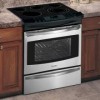Kenmore 4102 Use and Care Guide - Page 43
General, Care & Cleaning
 |
View all Kenmore 4102 manuals
Add to My Manuals
Save this manual to your list of manuals |
Page 43 highlights
General Care & Cleaning (cont'd) Do not use the following on the ceramic glass cooktop: • Do not use abrasive cleaners and scouring pads, such as metal and some nylon pads. They may scratch the cooktop, making it more difficult to clean. • Do not use harsh cleaners, such as chlorine bleach, ammonia or oven cleaners, as they may etch or discolor the cooktop. • Do not use dirty sponges, cloths or paper towels, as they can leave soil or lint on the cooktop which can burn and cause discoloration. Special Caution for Aluminum Foil and Aluminum Cooking Utensils • Aluminum foil Use of aluminum foil will damage the cooktop. Do not use under any circumstances. • Aluminum utensils Since the melting point of aluminum is much lower than that of other metals, care must be taken when aluminum pots or pans are used. Pans that boil dry may permanently damage cooktop by breaking, fusing to, or marking it. Care and Cleaning of Stainless Steel (StainlessSteel models only) Some models are equipped with stainless steel exterior parts. Special care and cleaning are required for maintaining the appearance of stainless parts. Please refer to the table provided at the beginning of the General Care & Cleaning section in this Use & Care Guide. Hinge lever J Hinge lever hook Hinc support _,.., Lock engaged for door removal Figure 1 HINGE SLOT - Door removed from the oven Figure 2 Removing and Replacing the Oven Door The door is heavy. For safe, temporary storage, lay the door flat with the inside of the door facing down. To Remove Oven Door: 1. Open the door to the fully opened position. 2. Pull up the lock located on each hinge support and engage it onto the hinge lever hook (Figure 1).You may have to apply a little downward pressure on the door to pull the lock fully over the hinge lever hook. 3. Grab the door by the sides and pull the bottom of the door up and toward you to disengage the hinge supports. Keep pulling the bottom of the door toward you while rotating the top of the door toward the range to completely disengage the hinge levers (Figure 2). 4. To clean oven door, follow the instructions provided in the General Care & Cleaning table. ...ii.i...... To Replace Oven Door: 1. Grab the door by the sides; place the hinge supports and levers into the hinge slots. Open the door to the fully opened position. 2. Disengage the lock from the hinge lever hooks on both sides (Figure 3). Note: Make sure the hinge supports are fully engaged before unlocking the hinge levers. 3. Close the oven door. Special Door Care Instructions - Most oven doors contain glass that can break. Read the following recommendations: 1. Do not close the oven door until all the oven racks are fully in place. 2. Do not hit the glass with pots, pans, or any other object. 3. Scratching, hitting, jarring or stressing the glass may weaken its structure causing an increased risk of breakage at a later time. Lock in normal position Figure 3 43















